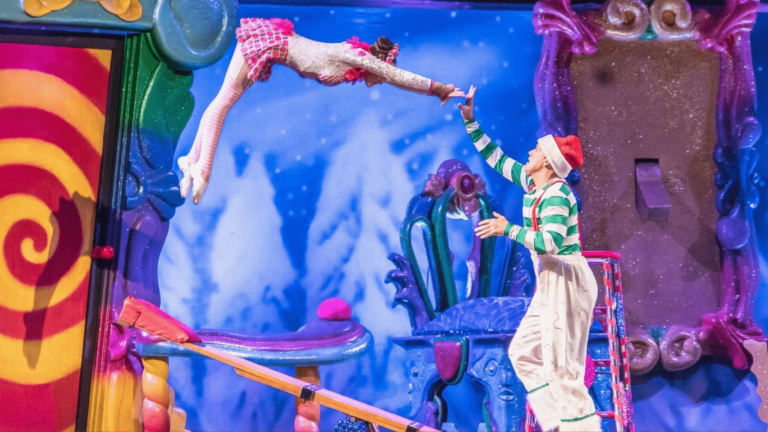Pantomime is as synonymous with Christmas in the UK as the King’s Speech and Brussels sprouts. The uniquely British musical and comedy stage productions, usually based on beloved children’s stories and fairy tales like Cinderella, Sleeping Beauty and Peter Pan, are a tradition that date back hundreds of years.
Despite panto’s long history, UK event creators are still finding weird and wonderful ways to give their productions a twist.
There’s huge demand for Christmas panto events — so if you’re an event creator considering organising your own pantomime this year, we want to help. The Eventbrite community is absolutely full of amazing creators staging unique panto events to learn from.
To help give you a little bit of context (and inspiration), this guide will walk you through what British pantomime is all about, when panto season is, the key elements your panto will need to succeed, and how to promote your panto extravaganza.
Table of contents
What are the key features of a British pantomime?
How to organise your own Christmas pantomime
What is British pantomime?
A pantomime (or “panto”) is a popular seasonal theatrical production that takes place every year across the UK, Ireland, and (to a lesser extent) some other English-speaking countries. Pantomimes are generally staged in the run-up to Christmas, and they combine musical theatre, slapstick comedy, newsworthy jokes, and utilise familiar stories to create a brand-new adventure.
Pantomimes have been a staple of the UK’s wide ranging Christmas traditions for hundreds of years. In fact, a recent YouGov survey found that 43% of Brits enjoy panto season (“Oh no they don’t! Oh yes they do!”).
So much so that pollsters at Norwich Theatre found that 85% of panto attendees say going to a Christmas pantomime is one of their most important Christmas traditions. A further 80% of people said going to the panto made them feel happier.
With satisfaction rates like that, it’s hardly surprising the humble panto has risen to become a staple within heritage theatres and professional West End productions, as well as amateur performances in village halls and schools across the country.

What is the origin of pantomimes in the UK?
Believe it or not, British pantomime actually traces its origins back to medieval Italian theatre. Deriving from Commedia dell’arte, the earliest pantomime productions started to take shape in the 16th century as a combination of music, dance, beautiful costumes, and acrobatics — all tied together by a cast of colourful characters.
Eventually, this Italian spectacle was imported into 18th century London by John Weaver. But it was John Rich and his portrayal of the Harlequin that introduced the modern clown into British society and enabled panto to really grow in popularity.
In the Victorian era, pantomimes evolved to introduce the “dame” — which is when a man portrays a key female role in drag. Since then, the songs, jokes, and fairytale settings have grown and developed over time. But the core foundation of the panto has remained pretty much the same.
When is panto season?
Pantomime season centres around the Christmas holiday — but some productions span the entire winter. Generally speaking, you can expect to start seeing panto productions in November. Large, professional pantomimes will often run until February.
But even though pantomime is all about the festive season, production teams start planning and rehearsing from the early spring. Even amateur theatre troops and youth casts will start preparing for their annual pantomimes in the summertime.
Despite the fact that pantomime is generally associated with Christmas, it has started to penetrate other UK holidays, too.
What are the key features of a British pantomime?
If you want to organise your own pantomime, it’s important to note that panto audiences tend to have certain expectations. Unlike other musical theatre productions or plays, pantomimes all share a set of key features that make panto a unique art form.
To help you get started planning, we’ll break down the things that keep panto audiences coming back for more.
Gender role reversal
We can’t emphasise enough how important the “dame” is in panto.
This classic gender role reversal totally anchors your typical pantomime. The dame is the one who keeps everybody on track for audiences. Dames are renowned for their eye-catching costumes, raucous jokes, and their ability to engage audiences.

A unique take on classic fairy tales
Pantomime shows are special because they connect such a wide range of audience members. One way they’re able to create a bridge between those audience members is by using familiar stories that everybody knows.
That’s why you’ll often see panto productions based on timeless classics like Peter Pan, Sleeping Beauty, Snow White, and Hansel and Gretel. But according to YouGov, the UK’s favourite pantomimes are Cinderella, Jack and the Beanstalk, and Aladdin.
By using a classic fairytale as the basis for your pantomime, you’re not only able to engage the whole family — but you’ll also benefit from easy opportunities for comedy by turning those well-known stories on their heads or localising them.
For inspiration, look no further than the City Academy’s 2023 panto, Beauty and the Beast.
Create custom tickets that build excitement for your event!

Slapstick comedy
Slapstick comedy is another great British tradition — so why wouldn’t it take centre stage in a pantomime?
It’s a fun way to engage with young kids — not always easy to do when you’re staging a live-action theatre production, so physical comedy will help you manage your audience.
Audience participation
Engaging a pantomime audience isn’t all about slapstick. A key tenant of the pantomime is audience participation — and it’s usually led by the dame.
Unlike other shows at the theatre, pantomime audiences are often encouraged to shout at the actors mid-performance. If you organise a panto, you’d better budget some time for children shouting “oh no they don’t!” and “he’s behind you!”
This adds an extra element of humour to the show and gives the actors a chance to improvise and ad lib on stage, which makes things more fun for them (and every show ends up a little bit different from the last). Colourful and flamboyant production
Another aspect of panto you need to get right is its flamboyance. By producing a panto, you’ll need to make sure you’re living up to its camp reputation.
Your show has to include nods to the Harlequin tradition and keep with the lavishness of the Christmas season. That means the fairest pantomimes of all will include vibrant colours, eye-catching outfits, and bright sets and backdrops.
How to organise and promote your own Christmas pantomime
Once you’ve decided to put on a Christmas pantomime and you’ve got a creative team on board, you’ll need to think about how you’re going to organise, promote, and run your event. Eventbrite is a fantastic place to start.
With Eventbrite, you can set up a custom event page for your panto that’s instantly searchable on the world’s biggest events database. But you can also share and promote that page on social, email, and everywhere in between.
You’ll also be able to set up different types of tickets and sell them online. With Eventbrite, you can even set up a custom seating chart to match your theatre space — so every ticket holder knows what to expect, whether your panto is in the Royal Albert Hall or your local village hall.
From there, you can use Eventbrite marketing tools to set up and automate social media ads, marketing emails, and customer communications to save you time and money getting your show’s name out there.
With the Eventbrite Organiser App, you can even check your attendees in or process payments for box office ticket sales — making things more convenient (and paperless) for both you and your audience.
Finally, Eventbrite’s analytics and reporting capabilities will let you discern your audience data to learn from your panto experience to make your next production even better.
If you’re looking for a way to engage with audiences at Christmas time and put on a show people will never forget, you can’t do any better than a pantomime. This British institution is a fantastic way to capitalise on festive spirit to create a winning show.
Start planning your pantomime today!






